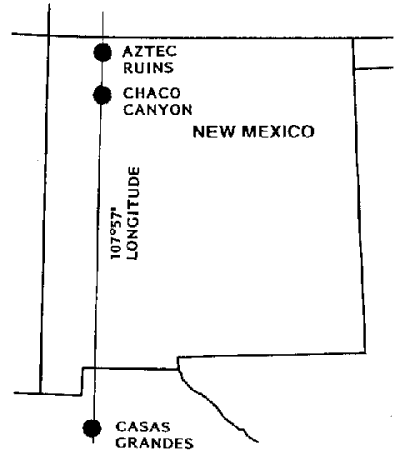 |
Science Frontiers ONLINE No. 111: May-Jun 1997 |
|
|
An Anasazi Ley Line?
A popular archeological pastime in Britain is "ley hunting" or the search for alignments of ancient sites. The underlying premise is that the peoples who constructed Stonehenge, Avebury, and other megalithic sites had a penchant for aligning them, even when they were separated by many miles. Exactly why anyone would wish to go to such trouble escapes the modern mind.
American archeologists generally eschew ley hunting, but S. Lekson, from the University of Colorado, was surprised to find that three important Anasazi sites in the Southwest are actually aligned with high precision along Longitude 107� 57'. The three sites are: Aztec Ruins and Chaco Canyon (New Mexico) and Casas Grandes (Mexico). Even though the first and last are separated by about 450 miles, all sites are within 1 kilometer (5/8 of a mile) of the north-south line. Lekson maintains that an alignment this precise cannot have happened by chance.
How could the Anasazi have achieved such an accurate alignment over such rugged terrain? It would not be easy even with modern transits.
(Cohen, Philip; "One Dynasty to Rule Them All," New Scientist, p. 17, December 14, 1996.)
Comment. It is interesting but perhaps not relevant that the Olmecs, predecessors of the Anasazi farther to the south, may have possessed the magnetic compass. See: Carlson, John B.; "Lodestone Compass: Chinese or Olmec Primacy?" Science, 189:760, 1975. (Reprinted in our Handbook: Ancient Man. To order this book, visit here.)
Reference. Ley lines and other ancient alignments are covered more thoroughly in our Handbook: Ancient Man. For details about this book, go here.
 |
These three major Anasazi sites are precisely lined up north and south. Was this intentional? |